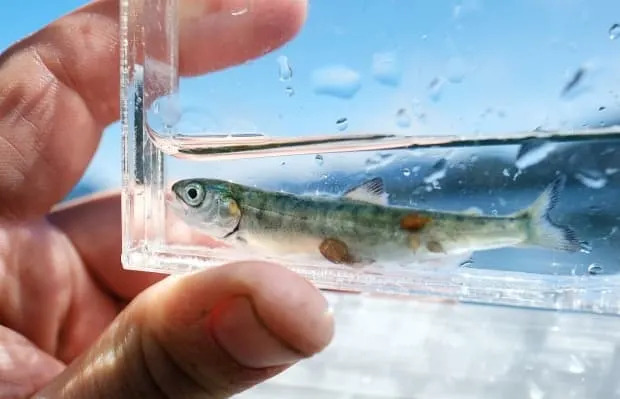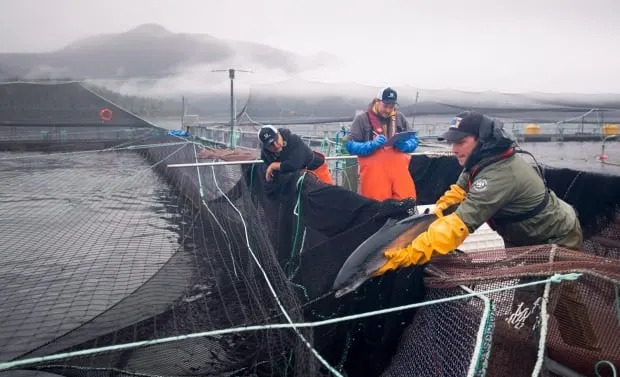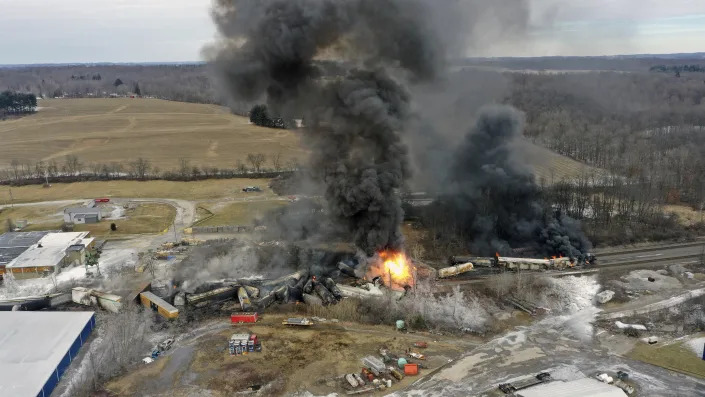Thu, February 23, 2023

Members of the DFO routinely visit farms surrounding British Columbia to make sure that the health of the salmon populations in fish farms is up to standard.
(The Canadian Press /Jonathan Hayward - image credit)
A federal decision to shut down 15 open-net Atlantic salmon farms around B.C.'s Discovery Islands is being lauded as a win for protecting wild salmon, and a significant blow to the fish-farm industry — all while reigniting a decades-old debate between industry and scientists.
The decision from Ottawa came just weeks after a Fisheries and Oceans Canada (DFO) report found no "statistically significant association" between sea lice infestations among wild juvenile chum and pink salmon and the fish farms they migrate past along the B.C. coast.
The report, which was based on data provided by fish-farm operators, noted there has been an upward trend of sea lice infestation in the studied areas, which include Clayoquot Sound and the Discovery Islands, since 2013.
The science establishing the link between salmon farms and increased sea lice infestations has been an issue of fierce debate for years, with industry representatives, academics, DFO scientists, and environmental activists citing conflicting data sets.
Even after announcing the decision to permanently close the 15 farms, the DFO didn't comment directly on the correlation between the two, saying by shutting down the farms it is taking an "enhanced precautionary approach."
"Recent science indicates that there is uncertainty with respect to the risks posed by aquaculture farms in the Discovery Islands area to wild Pacific salmon, and to the cumulative effect of any farm-related impacts on this iconic species," read a statement from the office of Minister of Fisheries and Oceans Joyce Murray.
"This was a difficult, but necessary decision."
A federal decision to shut down 15 open-net Atlantic salmon farms around B.C.'s Discovery Islands is being lauded as a win for protecting wild salmon, and a significant blow to the fish-farm industry — all while reigniting a decades-old debate between industry and scientists.
The decision from Ottawa came just weeks after a Fisheries and Oceans Canada (DFO) report found no "statistically significant association" between sea lice infestations among wild juvenile chum and pink salmon and the fish farms they migrate past along the B.C. coast.
The report, which was based on data provided by fish-farm operators, noted there has been an upward trend of sea lice infestation in the studied areas, which include Clayoquot Sound and the Discovery Islands, since 2013.
The science establishing the link between salmon farms and increased sea lice infestations has been an issue of fierce debate for years, with industry representatives, academics, DFO scientists, and environmental activists citing conflicting data sets.
Even after announcing the decision to permanently close the 15 farms, the DFO didn't comment directly on the correlation between the two, saying by shutting down the farms it is taking an "enhanced precautionary approach."
"Recent science indicates that there is uncertainty with respect to the risks posed by aquaculture farms in the Discovery Islands area to wild Pacific salmon, and to the cumulative effect of any farm-related impacts on this iconic species," read a statement from the office of Minister of Fisheries and Oceans Joyce Murray.
"This was a difficult, but necessary decision."
A flashpoint on the coast
At the centre of the debate is the question of whether wild salmon become infected by sea lice as they migrate past fish farms along the B.C. coast.
The Discovery Islands area is a key migration route for wild salmon, where narrow passages bring migrating juvenile salmon into close contact with the farms.
Parasitic sea lice occur naturally in the Pacific Ocean, but tend to thrive in fish farms because of the high density of fish. While sea lice don't generally harm adult fish, they can weaken or even kill young fish once they attach to their skin.
Salmon farms are required to perform monthly counts of the sea lice on their fish and make those numbers publicly available. The counts are self-reported, but fisheries officials perform occasional, pre-arranged audits to make sure the numbers are accurate.

Submitted by Mack Bartlett
A 2020 study found mandatory sea lice counts performed by the operators of the fish farms drop by between 15 and 50 per cent when they're not being done during an audit.
Brian Kingzett, executive director of the B.C. Salmon Farmers Association, said the industry and First Nations stakeholders were blindsided by the federal announcement after years of collaboration and consultation. Kingzett said the salmon farm industry has become a target for environmental activists and "a convenient scapegoat for the decline of wild salmon."
"Years and years of data have been provided by farm monitoring, by our licensed veterinarians and independent wild fish monitoring, that was commissioned by the industry," said Kingzett, speaking from Nanaimo.
"They could not find a causative correlation there. That goes along with what we've known for a long time from our internal data and the minister chose to ignore all that science."
In the initial news release about the decision, the DFO said wild salmon are facing a series of threats, including climate change, habitat degradation and both regulated and illegal fishing — threats Kingzett said aren't being addressed as aggressively as the farms.
"She's not going to shut down commercial fishing. She's not shutting down recreational fishing. She's not making sure that we have less pollutants going into the Strait of Georgia," he said.

Jonathan Hayward/The Canadian Press
Alexandra Morton, a marine biologist and independent researcher with 30 years experience in campaigning to save wild salmon populations, said she's relieved to see the decision from Murray.
"It's a brave decision by the minister because I know this was not easy," she said.
Morton said the conclusions reached in the DFO study from January reflected unreliable sampling data provided by farmers and consulting firms hired by them — a claim the farms deny. The DFO study does reference past reports that have found that infestations on both farmed and wild salmon were correlated within 30 kilometres of farms.
After the report was published, a group of 16 scientists slammed the report, citing inconsistencies and a lack of formal peer review.
"All these scientists see the same thing as I do. When you have salmon farms, you get sea lice on juvenile wild salmon. There's also infection with the viruses and the bacteria that are flourishing in these farms," said Morton.
Morton, who says her findings are backed up by researchers at the University of British Columbia, the University of Toronto, and other labs, has called on the industry to make its data available via OpenAccess, so that academics can conduct their own analysis and replicate the results independently.
"If they want to clear this up, just release their data," she said. "Let's have a look and have a rational discussion about this."
Morton said among the most reliable research methods, which has established a correlation between infections and farms, is genomic profiling, which can detect when fish immune systems are responding and becoming weakened.
Toxic debate
Researchers agree the question has turned not just divisive but toxic, resulting in online mudslinging and accusations of cherry-picking data.
When asked about the province's understanding of where the science stands, the Ministry of Water, Land and Resource Stewardship said in an email that the DFO "has the authority and the scientific expertise relating to licensing of aquaculture farms and B.C. looks to them to do this in a way that protects wild salmon health."
Kingzett said that while the industry doesn't always like the results of DFO findings, they stand by them.
"We have a situation where we have campaigning groups that have their scientists, we have our scientists, but we're always seen as industry," he said.
"We see this on social media all the time, that it's fraudulent, that there's a conspiracy."
Morton said the issue has in part become so polarized because scientists within the DFO are divided into two separate camps, putting the minister in charge in an impossible position.
"The DFO needs to reconcile in their own house. How can the regulating body have completely opposing scientists inside?" she said.
"It is a manufactured debate and it is extremely dangerous because at this point in the world we need to really look at what our impact is on the wild natural world."
Losses
Murray said the federal government is committed to developing a "responsible plan to transition from open-net pen salmon farming in coastal B.C. waters.''
The province said that it is disappointed the federal announcement "does not outline a federal support plan for First Nations, communities and workers that rely on salmon aquaculture for their livelihoods."
Kingzett said shutting down the farms will deal a devastating blow, with a 24 per cent reduction in production, up to 1,500 jobs at risk, and up to 10.7 million eggs and young fish euthanized. To make up for the decrease in locally-farmed salmon, fish are now being brought in from Chile and Norway.
"It's a big problem related to food security, to climate change, to wild fisheries. Instead of us coming up with comprehensive solutions, what we're doing is we're having an argument that just basically says burn it all down. We're farmers trying to do a good job," he said.







